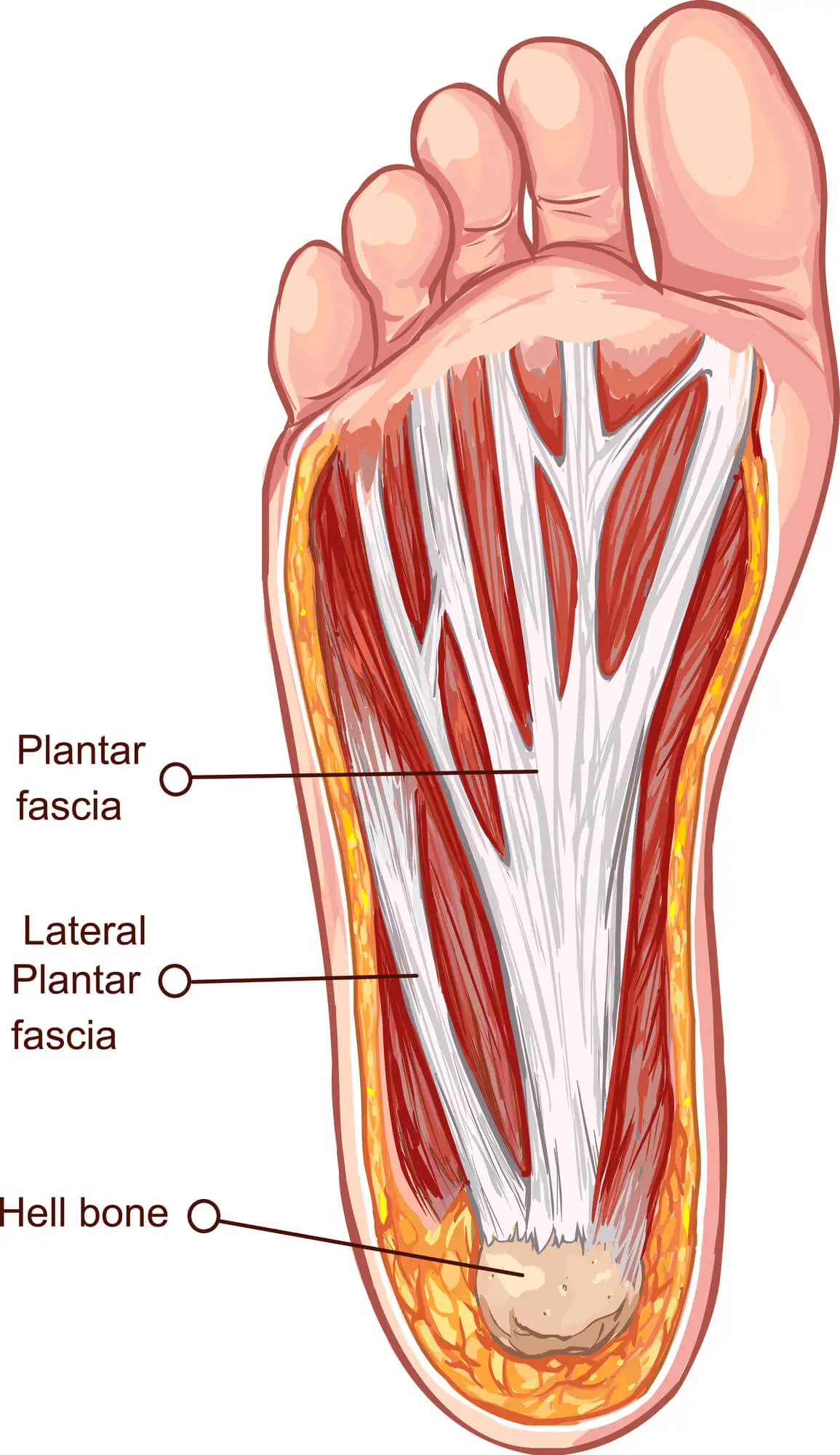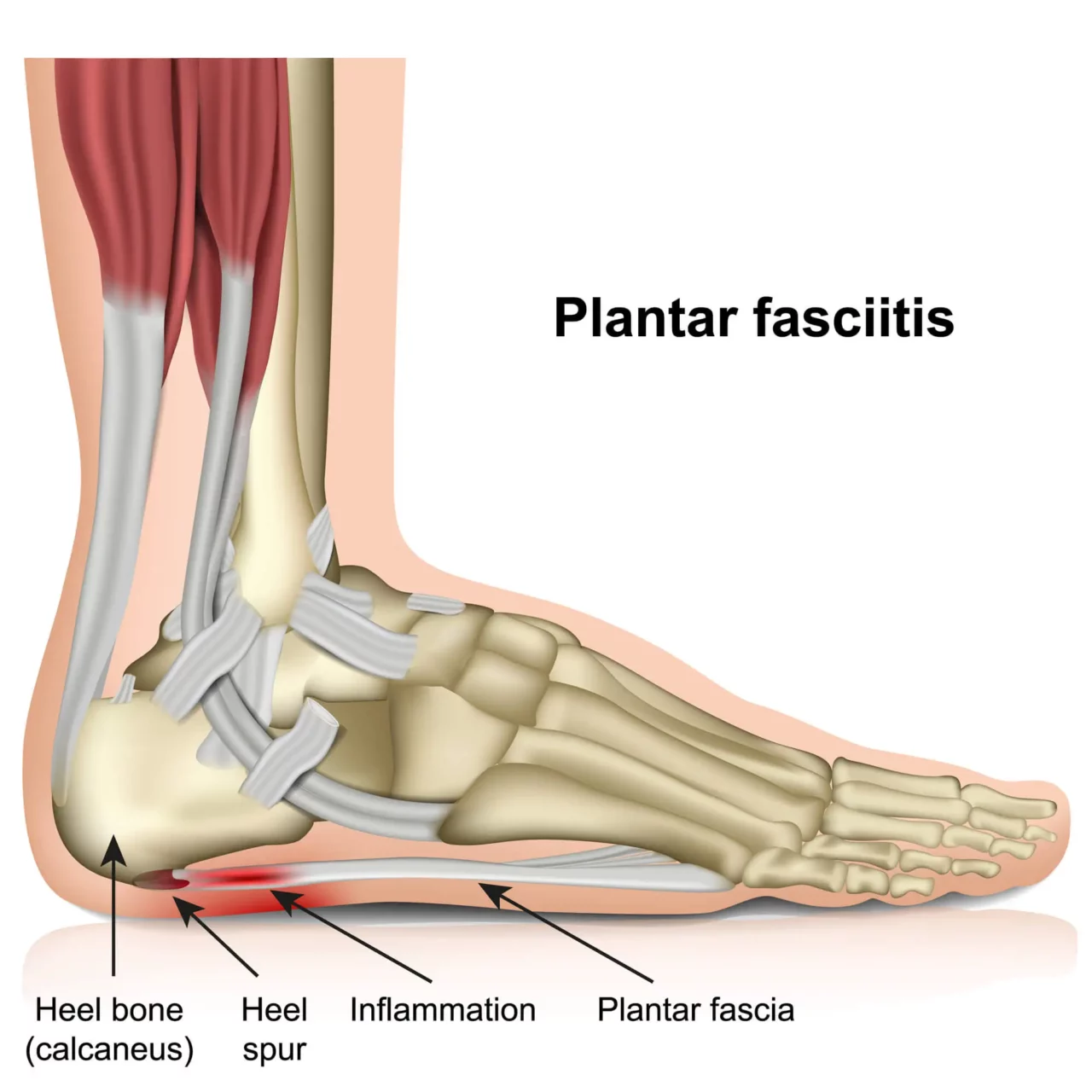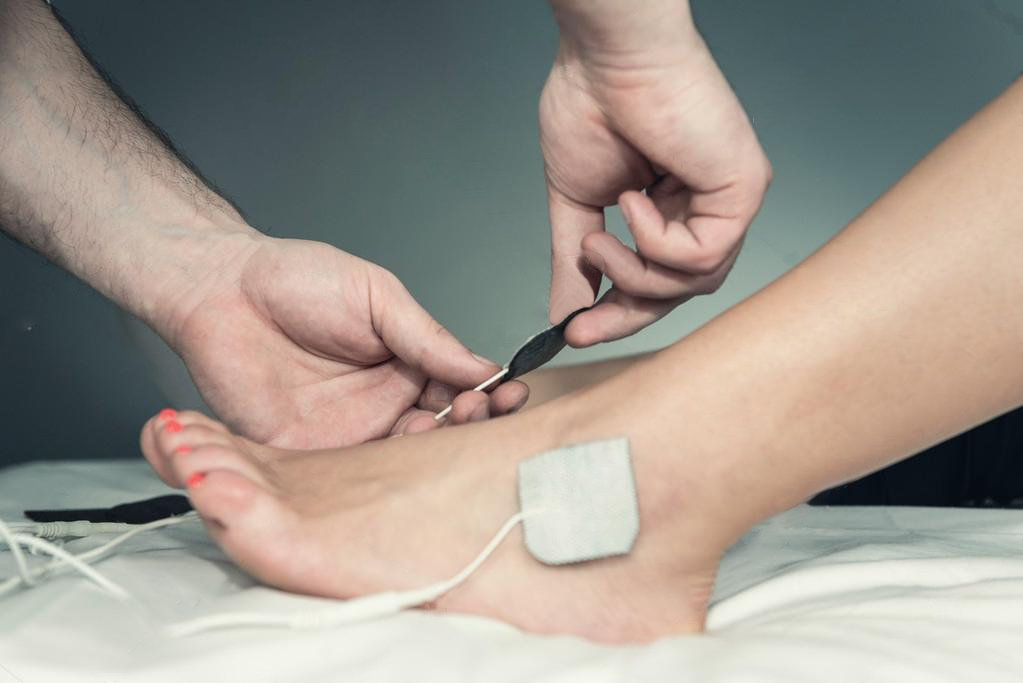Plantar Fasciitis

Does Plantar Fasciitis Cause Swelling?
Read More
June 29, 2023
If you have plantar fasciitis, the chances are that every step you take is accompanied by excruciating pain – a condition that makes it impossible to enjoy even the simplest of daily activities, like walking, climbing stairs, or being productive at work.
What’s more, this disorder is as common as it is life-limiting: 1 in 10 adults is estimated to suffer from heel pain during their life, and plantar fasciitis accounts for over half a million visits to healthcare clinics in the US alone.
And, if you are one of the 2 million people diagnosed with plantar fasciitis, you may face the prospect of having to take medications daily to manage your pain. Fortunately, you can now take advantage of a non-drug and non-surgical alternative to invasive or pharmaceutical treatments: electrical stimulation.
In this guide, we’ll look at how high-pulse electrical stimulation – when used as part of a whole-person Neurofunctional Pain Management protocol – can help you regain your foot health without drugs or surgery. Let’s dive in!
Plantar fasciitis is a pain disorder that affects the foot and heel. Also known as plantar heel pain (PHP), this condition is caused by inflammation, irritation, or damage to the fascia, which is a strong band of connective tissue that stems from the heel, runs along the bottom of the foot, and fans out to connect each toe to the heel.
Made of resilient collagen fibers, the fascia is responsible for providing support to the arch of the foot, stabilizing the gait, and absorbing shock from movements such as running, jumping, and walking.

The fascia can become inflamed, irritated, or torn due to several reasons, including:
In a 2015 study on the causes and risk factors of plantar fasciitis, nearly 90% of patients with this condition had a sedentary lifestyle.

Plantar heel pain may develop over time, starting with mild discomfort at the bottom of the foot. As the inflammation and damage to the fascia progresses, plantar fasciitis can begin to cause acute or chronic pain, often described as a stabbing sensation. The pain tends to intensify after periods of rest or after being on your feet for several hours, with the first steps in the morning being the most painful ones.
If left untreated, this condition can lead to a cascade of complications, including abnormal bone growths (heel spurs) and the permanent degeneration of the tissue of the fascia (plantar fasciopathy).
In most cases, plantar fasciitis resolves itself in 3-12 months, but not before forcing you to rely on pain medications, steroid injections, and even surgery to regain control of your daily life.
That’s where electrical stimulation comes in. Electrical stimulation (e-stim) is a pain management method that uses mild pulses of electrical current to provide long-lasting relief from pain, support the regeneration of damaged tissue, and induce an overall sense of well-being.
Let’s look at how this therapy works below.
Electrical stimulation uses electrical pulses that, when delivered to the area causing pain (the bottom of the foot and heel, in this case), provide relief from pain. This occurs due to several reactions that take place simultaneously thanks to e-stim:
One of the greatest benefits of electrical stimulation is that this therapy is non-invasive and non-pharmaceutical, which makes it suitable for almost everyone.
Plantar fasciitis can cause intense painful sensations that last months at a time. The pain can prevent you from moving your foot as you should, make each step excruciatingly painful, and get in the way of daily activities.
Thanks to the multiple actions provided by high-pulse electrical stimulation, you can regain your foot’s functionality without having to rely on medications. The benefits offered by this line of treatment are many, and include the following:
Electrical stimulation also plays a vital role in helping you avoid risk factors that, over time, can aggravate your condition. For example, if you suffer from heel pain, you may be tempted to avoid painful movements such as walking and running.
However, this can quickly become a vicious circle: avoiding movement can cause you to adopt a sedentary lifestyle, which often leads to conditions that worsen your heel pain, like obesity and being overweight.
Thanks to the analgesic action of electrical stimulation, you can return to your daily activities without pain and lead an active lifestyle, which is the foundation of long-term foot health.
As seen above, electrical stimulation refers to a pain management method that utilizes pulses of electrical current. However, depending on the nature, frequency, and strength of these pulses, it is possible to identify various forms of e-stim.
The low-pulse electrical stimulation therapies below are usually available as over-the-counter treatment options, which makes them equally accessible and inefficient. Indeed, to be able to be used safely by patients with no training or experience, they can only deliver extremely mild pulses of electricity, which are often not enough to provide relief from pain.
That’s where high-pulse, professionally-administered Electroanalgesia treatments represent a more valid alternative to access the benefits that electrical stimulation can provide.
Below, we’ll look at the different forms of electrical stimulation and why high-pulse Electroanalgesia represents a superior and more efficient option.
TENS – or transcutaneous electrical nerve stimulation – is arguably the best-known form of low-pulse electrical stimulation. In this therapy, low pulses of electrical current are delivered through (trans-) the skin (-cutaneous) via sticky pads that are applied to the areas that are causing pain.
TENS is widely available as an over-the-counter, easily accessible type of e-stim. It can be self-administered by patients, using a portable, battery-powered device attached to electrodes. Choosing the correct placement for the electrodes (usually along the bottom and on the top of the foot) and selecting an appropriate setting for the mild electrical pulses is all that’s required to perform TENS at home.
According to a 2009 study, TENS can reduce the pain from plantar fasciitis and improve foot mobility when used in combination with plantar fascia-specific stretching exercises and specialized orthotics.
We have a separate write up for TENS treatments for plantar fasciitis here, where we discuss just how effective an option this is.

NMES – or neuromuscular electrical stimulation – is a type of low-pulse electrical stimulation primarily used to strengthen weak muscles and relieve tension, spasms, and cramps.
If you suffer from chronic heel pain and abnormalities like bone spurs, you may be unable to move your foot and engage in activities like walking or running. Long periods of inactivity, immobilization, and bed rest can cause the muscles of your foot and leg to shrink, which leads to long-term inability.
Through NMES, your muscles can be retrained to contract and relax properly during periods of movement or rest. This is achieved by placing specialized electrodes around the foot and the bottom of the leg.
The mild electrical pulses will modulate the transmission of motor signals from the foot to the brain, causing contractions while you move your foot and relaxing the muscles while resting. This therapy may also be used if your plantar fasciitis is caused by prolonged immobilization of the foot (which can occur after surgery or an injury) or due to a sedentary lifestyle.
As shown by a 2018 study, an important fringe benefit of NMES is that this form of electrical stimulation can significantly strengthen foot muscles. In turn, stronger foot muscles are associated with improved gait and foot mechanics, better load distribution, and reduced pressure on the fascia.
IFC – or Interferential Current – is a form of low-pulse electrical stimulation that aims to support the healing of damaged tissues by promoting the circulation of blood, nutrients, and oxygen in the area affected by pain.
The healing effect of IFC results from the fact that this therapy delivers not one, but two pulses of electricity:
The variable frequency of the second pulse prevents the body from adapting to the current, which can reach further into the skin and tissues. According to a 2019 study, Interferential Current and Matrix Rhythm Therapies were effective in reducing heel pain and discomfort when coupled with strengthening exercises.
EMS – or Electronic Muscle Stimulation – works similarly to Neuromuscular Electrical Stimulation, but is mainly used to support the healing of damaged tissues, such as in the case of plantar fasciitis caused by tears in the fascia.
During EMS sessions, low-pulse electrical current is delivered through the skin near the nerve endings to stimulate healthy muscle contractions, reduce spasms, and relax tense muscles. These actions strengthen the muscles in the foot, which can reduce the pressure on the fascia, thus allowing it to heal.
According to a 2020 study, this form of electrical stimulation can also ease pain and reduce the thickness of the fascia if it has become swollen due to irritation and inflammation.
The low-pulse e-stim therapies seen above are non-invasive and non-pharmaceutical. As such, they come with minimal side effects and are generally considered safe for the majority of demographics.
Nonetheless, whether you are interested in at-home TENS or Interferential Current therapies, you should always start by consulting a specialized provider. After all, just like any other treatment, electrical stimulation isn’t equally suitable or safe for all patients.
Some contraindications to electrical stimulation include the following:
Consult a healthcare provider to determine whether you are eligible for this type of treatment.
Simply purchasing a TENS unit and self-administering electrical stimulation at home may seem an appealing option to reduce your foot or heel pain. However, using e-stim without the supervision of a specialized medical professional can expose you to a cascade of risks and side effects that should not be overlooked.
Even if the low power of at-home TENS units makes these devices generally safe, some drawbacks that you should be aware of include the following:
It is also important to note that if your heel or foot pain has not been properly diagnosed as plantar fasciitis, you may be aggravating another underlying condition that is at the source of the pain.
For example, if your chronic pain derives from a sedentary lifestyle, forceful movements performed at work or during sports, or obesity, using electrical stimulation may grant you temporary pain relief, but it can let the real cause of heel pain go untreated.
Ultimately, electrical stimulation can only be considered safe when administered by a specialized health professional, using an FDA-cleared device, and following a comprehensive health exam.
Although the principles behind the different forms of e-stim are similar, not all electrical stimulation therapies are created equal.
Certainly, over-the-counter alternatives like low-pulse TENS may seem accessible and easy to try. But the limited power offered by these therapies is inefficient at best and dangerous at worst. That’s why it is important to choose a superior, high-pulse, professionally-administered form of electrical stimulation: Electroanalgesia.
Used as part of a more comprehensive whole-person approach that includes IV Therapy and Lifestyle Counseling, the high-frequency electrical pulses delivered through Electroanalgesia can provide long-lasting relief from chronic and acute plantar fasciitis pain.
Here is how high-pulse Electroanalgesia works as part of tailored Neurofunctional Pain Management programs designed at Relatyv.
Unlike the limited, low-pulse current delivered by at-home TENS units, electroanalgesia is able to deliver over 10,000 electrical pulses per second. Such high frequencies penetrate deeper into the tissues and provide greater stimulation to the nerve endings.
As a result, through regular high-pulse Electroanalgesia sessions, you’ll be able to benefit from longer-lasting relief from pain, accelerated healing of damaged tissues, and healthier blood circulation.
The high-frequency electrical pulses delivered through Electroanalgesia efficiently prevent pain signals from reaching the brain and modulate the way your neurons process sensory signals. This action resets your perception of pain, which provides permanent relief from chronic pain.
What’s more, in Neurofunctional Pain Management, high-pulse Electroanalgesia is combined with IV Therapies and Lifestyle Counseling programs. Used together, these approaches reduce inflammation, provide long-lasting hydration, address nutritional deficiencies and imbalances, and modify the risk factors of plantar fasciitis (i.e.: a sedentary lifestyle).
Painful sensations are transmitted and processed in the brain by three types of fibers: A-beta, A-delta, and C-fibers. A-beta and A-delta fibers transmit painful sensations that are deep, sharp, lancinating, and easily localized. These painful sensations may be acute but last for brief periods.
On the other hand, C-fibers are responsible for transmitting pain signals relating to more generalized aching pain. These sensations are more tolerable but longer lasting. Electroanalgesia modulates the action of these nerve fibers to interfere with the transmission of generalized pain signals from the sole of the foot to the brain, thus offering relief from chronic pain.
The high-frequency pulses of electricity also trigger the release of endorphins, which are the body’s natural painkillers able to counteract painful sensations and offer a generalized sense of well-being.
Given the high frequency of the electrical pulses delivered during high-pulse Electroanalgesia programs, this treatment is administered by a specialized medical provider at Relatyv using an FDA-cleared device.
The electrodes are placed accurately and the settings are adjusted based on comprehensive medical exams, thus eliminating any risk to your health.
Although it is recommended to undergo two sessions of electroanalgesia a week for 6-12 weeks to obtain the expected results, this superior form of electrical stimulation is able to provide long-lasting relief from heel or foot pain.
At Relatyv, the Neurofunctional Pain Management protocols we design for each and every one of our patients aims to address the underlying causes of your foot conditions and treat pain without surgery or medications.
When coupled with IV Therapy programs and ad hoc Lifestyle Counseling services, Electroanlgesia can help you magnify your quality of life today and lay the foundations of long-term health.
Through superior, non-invasive, and non-pharmaceutical alternatives like Electraonlgesia, our mission is to become the first thought, first choice, and first step in your fight against chronic foot pain.
About the Author
Will is a healthcare executive, innovator, entrepreneur, inventor, and writer with a wide range of experience in the medical field. Will has multiple degrees in a wide range of subjects that give depth to his capability as an entrepreneur and capacity to operate as an innovative healthcare executive.
Share on Social Media



You can see how this popup was set up in our step-by-step guide: https://wppopupmaker.com/guides/auto-opening-announcement-popups/
You can see how this popup was set up in our step-by-step guide: https://wppopupmaker.com/guides/auto-opening-announcement-popups/
Neurofunctional Pain Management Overview
Symptoms
Conditions Treated
Treatments
Articles by Category
Locations
Colorado
Wisconsin
Georgia
Hiram
Lawrenceville
Marietta
Powder Springs
Texas
Waco
Victoria
Illinois
Buffalo Grove
New Lenox
St. Charles
Arizona
Tucson
Waddell
Arlington
Avondale
Buckeye
Superior
Mesa
Palo Verde
Morristown
Tempe
Chandler
Anthem
Eloy
Florence
Fort McDowell
Phoenix
El Mirage
Coolidge
Gilbert
Arizona City
Casa Grande
Casa Blanca
Aguila
Sacaton
Apache Junction
Kearny
Stanfield
Goodyear
Litchfield Park
Alabama
Arkansas
California
Florida
Idaho
Indiana
Iowa
Kansas
Louisiana
Maryland
Michigan
Rhode Island
Minnesota
Mississippi
Nevada
New Jersey
New Mexico
North Carolina
Ohio
Pennsylvania
South Dakota
Tennessee
Utah
Virginia
Washington


